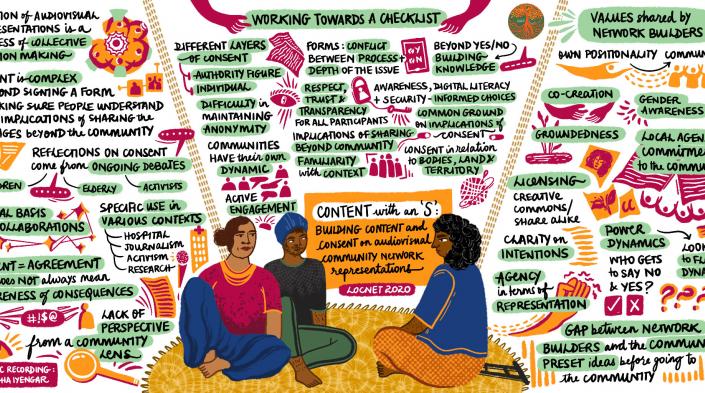 Illustration: Sonaksha Iyengar
Illustration: Sonaksha Iyengar
Dernière mise à jour de cette page le
Q: How did this guideline emerge?
A: Creating more visibility and knowledge around the work of community networks (CNs) is a key concern of the Locnet project. Within Phase 2 of our project, we will invite all interested CNs to produce fresh audiovisual material in order to present their organisations and innovative work. We see this as a chance to share experiences and best practices within the CN ecosystem and as a way to also attract potential funders. The ultimate goal of these productions is for community networks to become more visible through audiovisual formats, which are easy to share with other networks and will help attract more networks. The production of the videos is meant to be a moment of co-creation and production. As we walk together, questions will emerge, so we will delve deeper into them and provide some answers. This document is already a first collaborative output that includes the expertise of different Locnet team members and peers. The section on "mindful production" draws on the joint reflection that took place during our workshop, "Content with an S" in August 2020.
Q: What is the context where these video clips are being produced?
A: It is you who can tell the best stories about community networks, and this is why the production of audiovisual material should also be envisioned from a community perspective. Instead of bringing in a professional film crew and limiting your capacity to be in front of the camera, we suggest exploring together a participatory method of video documentation. There is no fixed set of rules on how to do this, but rather some guiding principles:
-
Network builders and community members participate in the creation of a story to tell.
-
You reach out for external facilitation (for example, with editing) whenever needed but remain an active agent of all production processes.
-
Locnet team members and the APC communications team provide feedback and assistance throughout the production process.
-
You decide how to distribute and publish the final material.
Q: What is the purpose of the video clips?
A: To increase the visibility of innovative tech development, adoption and social uses of community networks around the world.
Q: Who is the target audience of the video clips?
A: Basically there are two:
-
other CNs who can learn and benefit from the shared experiences and
-
possible funders who can get a closer look at the relevance of your work.
Q: What is the expected duration of the video clips?
A: As the general format of “clip” suggests, the videos are introductions of your work and should be around 5-7 minutes in length, not longer.
Q: What is the story outline for the videos?
A: You are free to decide how you tell your story. Recommended elements are:
-
Key people in your organisation or local CN who take us “to the place”.
-
Footage that introduces the specific setting (community, geographic surroundings, etc.).
-
Short introduction/explanation of the technology being used.
-
Testimonials of people from the community reflecting on their user experiences or sharing future expectations and visions around the technology being used.
Q: What should you be mindful of when producing your video?
A: Take time to reflect on the process of consent and the values of autonomy, agency, ableism, memory and privacy before, during and after production.
-
Did you ask for and receive consent for folks to be filmed?
-
Were the images/videos shown to them for approval?
-
Have you shared with the community what the collected information is going to be used for, as well as where and for how long it will be archived?
-
Are there any landmarks or personal marks that need to be protected/blurred out?
-
Are there concerns around showing the "space" or territory?
-
Has the community consented with the way it is portrayed in the video, in terms of representation?
-
Have you made sure to put in place a step-by-step approach to consent? (Remember, people might consent to some things but not others.)
-
Is there a time period for the use of the material?
-
Are there young or older people in the images and videos who might not have been able to provide consent?
-
Is the production aligned with your community values?
-
Whose gaze is showing in the production?
-
Are you and the community in agreement and clear on the implications of making that content public beyond the community?
-
Do you share an understanding of privacy?
-
Is it accessible to people with vision impairment or low vision? Would subtitles or a transcript support the hearing impaired in accessing your production?
Q: What is the video format required?
A: APC tech is working on a long-term standard for this. For the recording and production, you should use the formats you feel most comfortable with. Check the options of your cameras and editing software, choosing formats that are easily interchangeable and provide good quality. Usually, the best formats to export to are .MP4 or .MOV. Please contact us if you would like further suggestions and advice.
Q: Who should produce the clip?
A: We encourage you to produce the material with members from your CN or the community you are working with. In case it is difficult to produce the material without external help, we recommend teaming up with documentary filmmakers or other qualified persons who share the values of your work.
Q: What are the production steps? (pre, during and post production)
A: The first step is development of a concept note and the creation of a specific production plan. This plan can look slightly different, depending on the topic and the people involved. However, as a guideline we suggest working with the following scheme:
-
Development of a concept note: Try to answer the questions what, where, with whom? (Locnet can assist with this process.) Here is a nice example of a video concept note.
-
Discussion of the initial concept note with Locnet and outline of next steps (including production plan and eventual treatment).
-
Film work (including revision and edition of already existing material).
-
Round of feedback and reflection (leading to the preparation of a script).
-
Production of a first version of the video clip.
-
Discussion of the first version and agreements on final production.
-
Final round of revisions and addition of translation.
-
Publication of the produced material.
Q: What is the best hardware and software to produce the videos?
A: There is no simple answer to this question. The available equipment and software varies, and people you are working with could have their own preferences and ideas. The best approach is to evaluate the available equipment and capacities beforehand. Remember that interesting stories and visually impressive videos have been recorded with smartphones, and great editing results have been achieved with simple editing software. It's your story that counts, so don't get intimidated by technological means. To think of adequate light conditions and to be aware of good audio quality (avoiding background noise, wind, etc.) are often more important than professional equipment. We can assist you individually on tech questions and find more precise solutions together.
Q: How are the production steps coordinated?
A: A team from Locnet, composed of tech innovation coordinators, regional coordinators and other supporting team members will discuss your initial ideas and continue to accompany the production. In this way you will receive experienced feedback during the whole process of creation.
Q: What is the production timeline?
A: The timeline for production will be established during the initial discussion, but should take place in 2020. In general, a suggested timeline would be 2-3 months, from the first brainstorming session to the final version.
Q: Once our video is finalised, where will it be published?
A: You are free to publish it on your website, or on your audiovisual platform channels (YouTube, Vimeo, etc.). APC will publish the videos on its self-hosted audiovisual platform, https://videos.apc.org/. If you don't have space on any audiovisual platform, do not worry - we've got you covered!
Q: How do we promote our video?
A: There are many ways to disseminate your audiovisual production: press releases, social media posts (e.g. Twitter, Facebook, Instagram, Mastodon, etc.), posting articles or blog posts announcing the video and/or featuring "behind the scenes" of the production, interviews with protagonists in the videos/producers, and more! APC will support the international dissemination of your work, and we would appreciate your help in reaching local audiences.
Q: What kind of licensing should we use for our video?
A: We encourage you to use a Creative Commons license, since this enables sharing and reuse of creativity and knowledge through the provision of free legal tools. If you are comfortable with it, we encourage you to specifically adopt a Creative Commons Attribution 4.0 International (CC BY 4.0) license, which allows people to share (copy and redistribute the material in any medium or format) and adapt (remix, transform and build upon the material for any purpose, even commercially). For more information, see https://creativecommons.org/licenses/by/4.0/.
Q: How is the production financed?
A: Locnet supports the production with up to a maximum of USD 600 (this does not include translation and subtitles).
Q: Who should we credit in our video?
A: It is always important to credit all the people who were involved in the production of the video to acknowledge their contributions – always ask permission to do this in advance. Institutionally speaking, as these videos are part of the Locnet project, funded by Sida, we would appreciate acknowledgment to both APC and Sida at the end of the video. You can use the following sentence: This video is part of the "Connecting the Unconnected: Supporting community networks and other community-based connectivity initiatives" project implemented by the Association for Progressive Communications (APC) in partnership with Rhizomatica, with funds from the Swedish International Development Cooperation Agency (Sida).
Annex: Good reads


